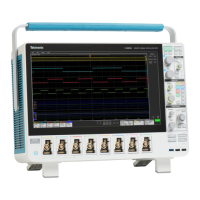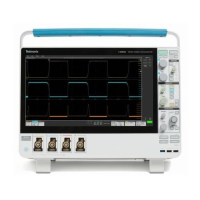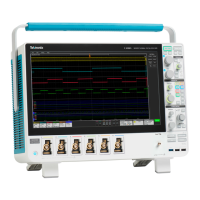MCross calculations. MCross1, MCross2, and MCross3. refer to the first, second, and third MidRef cross times, respectively.
The polarity of the crossings does not matter for these variables, but the crossings alternate in polarity; that is, MCross1 could be
a positive or negative crossing, but if MCross1 is a positive crossing, MCross2 will be a negative crossing.
Figure 21: MCross Calculations
The instrument calculates these values as follows:
1. Find the first MidRefCrossing in the waveform record or the gated region. This is MCross1.
2. Continuing from MCross1, find the next MidRefCrossing in the waveform record (or the gated region) of the opposite polarity
of MCross1. This is MCross2.
3. Continuing from MCross2, find the next MidRefCrossing in the waveform record (or the gated region) of the same polarity as
MCross1. This is MCross3.
MCross1Polarity. is the polarity of first crossing (no default). It can be rising or falling.
StartCycle. is the starting time for cycle measurements. It is a floating-point number with values between 0.0 and (Record
Length – 1.0), inclusive.
StartCycle = MCross1
EndCycle. is the ending time for cycle measurements. It is a floating-point number with values between 0.0 and (Record Length
– 1.0), inclusive.
EndCycle = MCross3
Waveform[<0.0 ... RecordLength–1.0>]. holds the acquired data.
TPOS. is the location of the sample just before the trigger point (the time reference zero sample). In other terms, it contains the
domain reference location. This location is where time = 0.
TSOFF. is the offset between TPOS and the actual trigger point. In other words, it is the trigger sample offset. Values range
between 0.0 and 1.0 samples. This value is determined by the instrument when it receives a trigger. The actual zero reference
(trigger) location in the measurement record is at ( TPOS + TSOFF).
Oscilloscope reference
DPO70000SX, MSO/DPO70000DX, MSO/DPO70000C, DPO7000C, and MSO/DPO5000B Series 689
